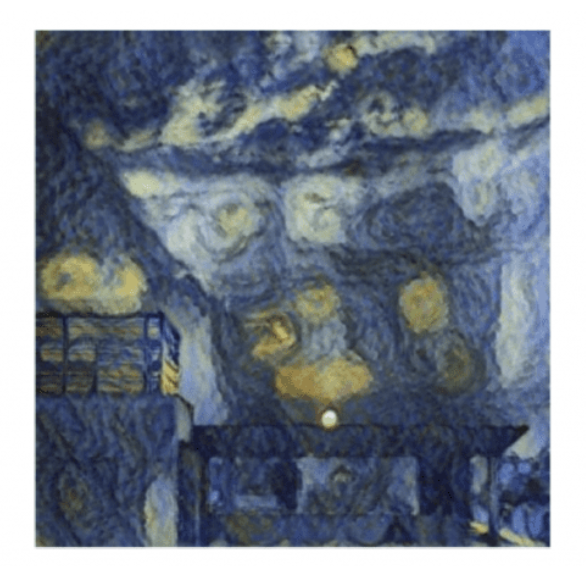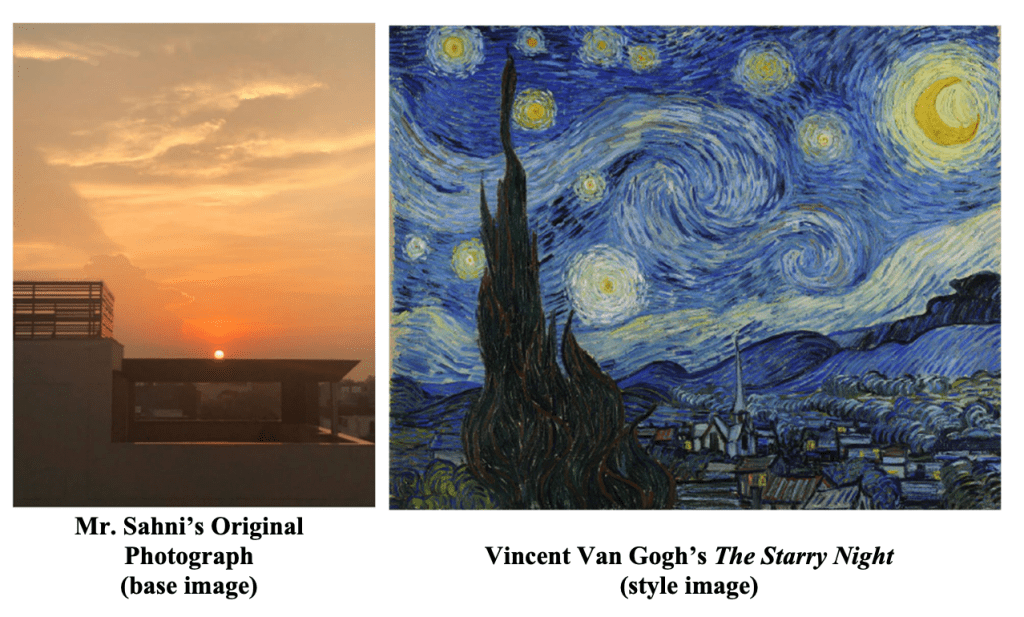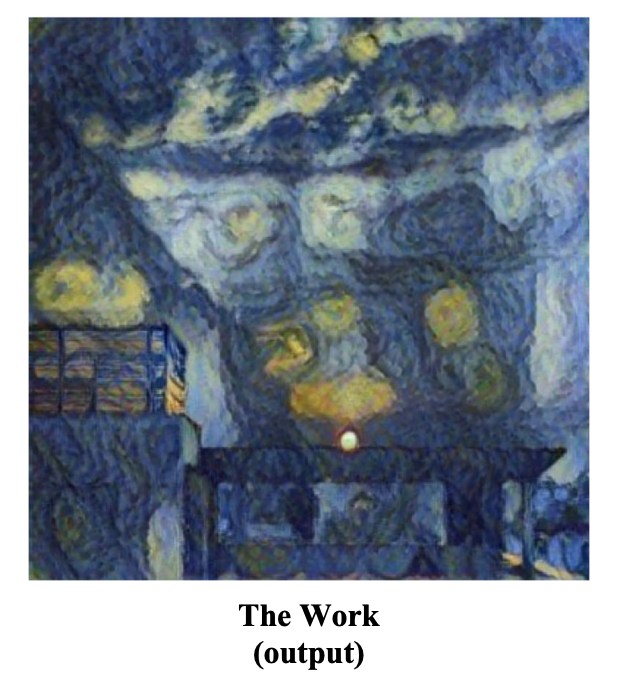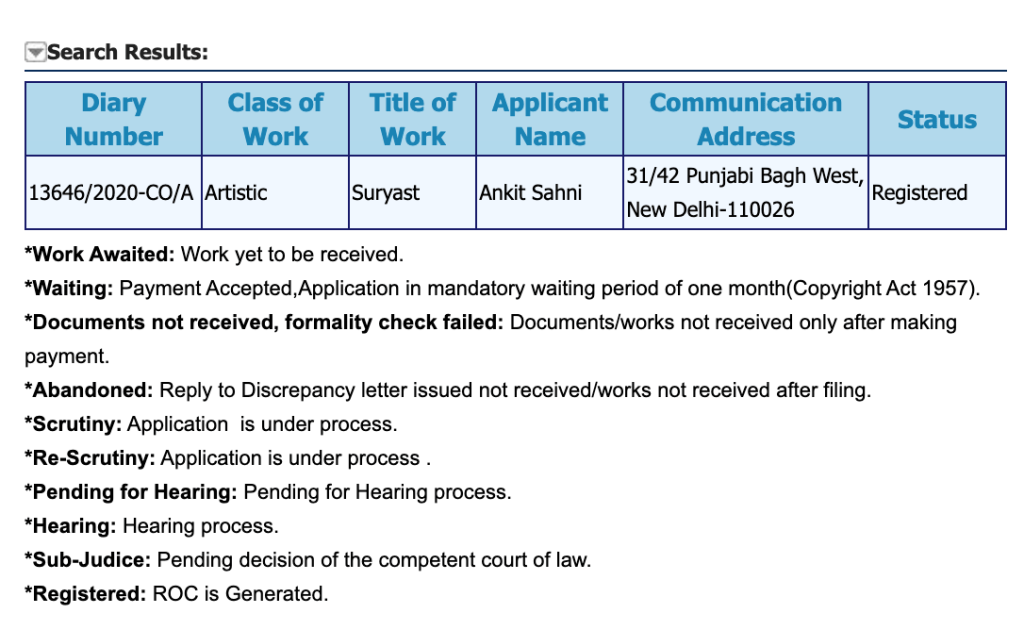US Copyright Office issues another ruling on AI-authorship and copyright, reaffirming its decision to reject Ankit Sahni and RAGHAV’s artistic work. Discussing this development, we are pleased to bring to you this post by SpicyIP intern Vedika Chawla, with inputs from Swaraj. Vedika is a third-year B.A.LL.B. (Hons.) student at National Law University, Delhi.

Ankit Sahni’s AI “Co-authored” Artwork Denied Registration by US, Continues to be Registered in India
By Vedika Chawla
The Review Board of the US Copyright Office (USCO) reaffirmed the decision to deny copyright registration to Ankit Sahni’s artwork titled ‘Suryast,’ which was created by the use of AI technology. The Copyright Office had earlier refused registration for the artwork for lack of human authorship necessary to support a copyright claim. Interestingly, the artwork also led to controversy in India when it was granted registration in November 2020 (Dairy no. 13646/2020-CO/A; RoC no. A-135120/2020.)
What is the Artwork and How was it Created?
Ankit Sahni, an artist and lawyer, commissioned an AI-based tool that generates artistic works, by the name RAGHAV (‘Robust Artificially Intelligent Graphics and Art Visualizer’) in 2020. The application filed by Mr. Sahni before the USCO for registration of Suryast enlisted himself and RAGHAV as co-authors of the “2-D artwork”, claiming that the contributions of the AI tool were distinct and independent from his own. The artwork was generated by feeding a digital photograph authored by Mr. Sahni into RAGHAV along with an image of Vincent Van Gogh’s The Starry Night as the ‘style’ input. As per Mr. Sahni’s explanation of the working of RAGHAV, he could control the extent of ‘style transfer’ from the style input in the software. The generated image was a rendition of the base photograph adapted to the style from Van Gogh’s painting.


What Did the USCO Order Say?
When declining registration originally, the USCO had emphasised the lack of human involvement and authorship in the artwork to claim a copyright, and that the element of human authorship in the artwork could not be distinguished from the final work produced by the AI tool. Mr. Sahni had then filed the first request for reconsideration, arguing that the requirement of human authorship could not be understood as a requirement for entirely human authorship, and that the artwork was the result of creative choices by a human author which determined the degree of stylisation of the base image. In response, the USCO Board reaffirmed its position, stating that the final image was a derivative work. Analysing whether the new authorship contributed sufficiently over the base image, the USCO found that the new creative additions were of RAGHAV and not Mr. Sahni, thus not warranting copyright registration.
Mr. Sahni then filed a second request for reconsideration with three arguments: first, that RAGHAV was a merely assistive software and the main inputs were his own; second, that the base image and the directions for stylisation were clear human elements of authorship in the artwork; and third, that the work is not a derivative work because it is not substantially similar to the original image. In response to this request, the USCO reiterated the legal position that creations of non-humans may not be protected by copyright, and an element of human creativity must have occurred for any work to be copyrightable. As per the March 2023 notice of registration guidance issued by the USCO, an AI-generated work may be protected where it is “basically of human authorship” with the AI tool being merely assistive. In other words, the traditional creative aspect of the work must be conceived by man and not machine.
Applying this legal standard to Mr. Sahni’s case, the USCO concluded that Mr. Sahni’s decisions involved in creation of the artwork, i.e. the input of a base image and a style image and the specific variable value determining degree of style transfer, do not constitute sufficient human authorship. “Here, RAGHAV’s interpretation of Mr. Sahni’s photograph in the style of another painting is a function of how the model works and the images on which it was trained on—not specific contributions or instructions received from Mr. Sahni.” Simply put, Mr. Sahni only decided what elements are to be incorporated in the final artwork, while the RAGHAV app determined how they are to be incorporated, the latter being the main creative input. It also stated that the second request by Mr. Sahni “inaccurately minimises RAGHAV’s role” in the creation of ‘Suryast.’
Can AI-Generated Work be Protected?

The USCO’s refusal of registration to Mr. Sahni was it’s fourth instance of denial of protection to AI-generated content on the same grounds of lack of human authorship, including in the Thaler case. Mr. Sahni had also applied for registration of the copyright in India, which was interestingly granted in November 2020, making him the first person to have secured copyright protection for AI-generated content. However, the Indian Copyright Office subsequently issued a withdrawal notice, asking Mr. Sahni to provide further information regarding the legal status of the AI tool RAGHAV. Emphasising Sections 2(d)(iii) and 2(d)(vi) of the Copyright Act, 1957, the notice highlighted that an ‘author’ must be an artist or any person who causes the artistic work to be created. Mr. Sahni had then responded to the notice arguing that the Copyright Office did not have the authority to review its own decision. It appears that no action has been taken, as it still is listed in the copyright registry
Mr. Sahni had also successfully secured copyright registration for ‘Suryast’ in Canada, where an author of a protected work must necessarily be human. Speaking about this, Mr. Sahni said that his creativity and skills were inseparable from the contribution of the AI tool, and therefore, they were co-authors, or joint authors under the Canadian law.
Recently, in a first, the Beijing Internet Court held that AI-generated content may be granted copyright protection where they possess an element of originality. The case revolved around an image created by an AI tool as per instructions of the Plaintiff, and the court recognised that the essential elements of the image were the product of the “intellectual investment” of the Plaintiff and the AI software was a mere tool. Here as well, the Court did not recognise the AI tool as an author, though, and maintained that since the selection and arrangement of inputs was done by the Plaintiff, he would be considered the author. Evidently, a similar reasoning was argued by Mr. Sahni before the USCO but was not accepted. While the mode of operation of every AI tool and its impact on human authorship must be assessed on a case-by-case basis, it is interesting to see whether there are clear differences in policy positions in different jurisdictions.
A curious case, therefore, arises for the human author working with an AI tool to defend. It is unclear how an entity not qualified to be an author for lack of humanity may be considered a joint author in jurisdictions such as Canada. The argument in favour of this position would necessarily have to be that considerable creative inputs are provided by the AI, such as how to incorporate the style input in the case of RAGHAV. However, in jurisdictions such as the US, which place importance on the human authorship requirement, the human author may have to forego the emphasis on the contribution of the AI tool, and seek protection of the content solely on the basis of the human creativity element.
Legislative clarity is needed in light of the ever-increasing use of generative AI, and jurisdictions must answer several questions. Are they willing to recognise a non-human AI entity as an author at all? If yes, is co-authorship by a human author necessary, and what is the degree of creative contribution by both that is acceptable? If not, how can it be determined that the use of AI tools is not dampening the actual copyrightable creative inputs of the human author in any given case? This line of inquiry has, in the US, been somewhat addressed through the Thaler and the Jason Allen cases, protection was denied to both applicants, the former on the basis of ineligibility of an AI tool to be an author, and the latter on the grounds that the contribution of the AI tool was more than de minimis. It remains to be seen how India and other jurisdictions tackle these questions. There is also an increasing recognition of the need to instate transparency and disclosure requirements associated with the use of AI to generate content, most recently in the EU AI Act. Regardless of whether jurisdictions intend to recognise AI tools as legitimate ‘authors’ capable of claiming copyright protection, including such a disclosure requirement at the stage of filing of applications might be something to consider. An explanation as to the nature and degree of contribution of the AI tool in any given creation may allow for greater clarity in the review of the application.
